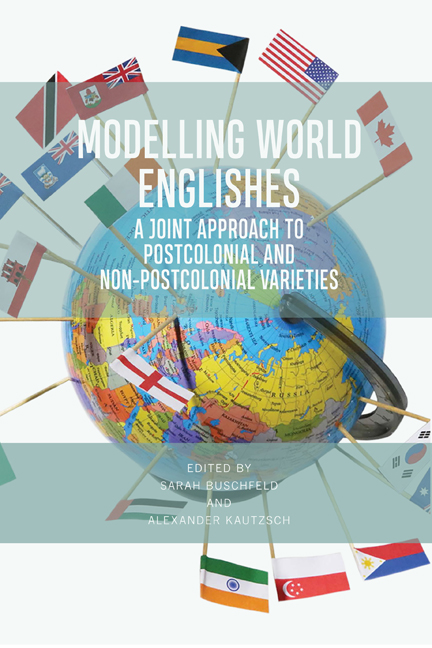Book contents
- Frontmatter
- Contents
- List of Figures and Tables
- List of Contributors
- Foreword
- 1 Introduction
- 2 English in England: The Parent Perspective
- 3 English in Namibia: Multilingualism and Ethnic Variation in the Extra- and Intra-territorial Forces Model
- 4 English in the United Arab Emirates: Status and Functions
- 5 English in India: Global Aspirations, Local Identities at the Grassroots
- 6 English in Singapore: Two Issues for the EIF Model
- 7 English in the Philippines: A Case of Rootedness and Routedness
- 8 English in South Korea: Applying the EIF Model
- 9 English in Japan: The Applicability of the EIF Model
- 10 English in Australia – Extra-territorial Influences
- 11 English in North America: Accounting for its Evolution
- 12 English in The Bahamas and Developmental Models of World Englishes: A Critical Analysis
- 13 Standard English in Trinidad: Multinormativity, Translocality, and Implications for the Dynamic Model and the EIF Model
- 14 Englishes in Tristan da Cunha, St Helena, Bermuda and the Falkland Islands: PCE, non-PCE or both? Blurred Boundaries in the Atlantic
- 15 English in Ireland: Intra-territorial Perspectives on Language Contact
- 16 English in Gibraltar: Applying the EIF Model to English in Non-Postcolonial Overseas Territories
- 17 English in Ghana: Extra- and Intra-territorial Forces in a Developmental Perspective
- 18 Synopsis: Fine-tuning the EIF Model
- Index
11 - English in North America: Accounting for its Evolution
Published online by Cambridge University Press: 24 September 2020
- Frontmatter
- Contents
- List of Figures and Tables
- List of Contributors
- Foreword
- 1 Introduction
- 2 English in England: The Parent Perspective
- 3 English in Namibia: Multilingualism and Ethnic Variation in the Extra- and Intra-territorial Forces Model
- 4 English in the United Arab Emirates: Status and Functions
- 5 English in India: Global Aspirations, Local Identities at the Grassroots
- 6 English in Singapore: Two Issues for the EIF Model
- 7 English in the Philippines: A Case of Rootedness and Routedness
- 8 English in South Korea: Applying the EIF Model
- 9 English in Japan: The Applicability of the EIF Model
- 10 English in Australia – Extra-territorial Influences
- 11 English in North America: Accounting for its Evolution
- 12 English in The Bahamas and Developmental Models of World Englishes: A Critical Analysis
- 13 Standard English in Trinidad: Multinormativity, Translocality, and Implications for the Dynamic Model and the EIF Model
- 14 Englishes in Tristan da Cunha, St Helena, Bermuda and the Falkland Islands: PCE, non-PCE or both? Blurred Boundaries in the Atlantic
- 15 English in Ireland: Intra-territorial Perspectives on Language Contact
- 16 English in Gibraltar: Applying the EIF Model to English in Non-Postcolonial Overseas Territories
- 17 English in Ghana: Extra- and Intra-territorial Forces in a Developmental Perspective
- 18 Synopsis: Fine-tuning the EIF Model
- Index
Summary
INTRODUCTION
It is debatable whether American English (AmE) constitutes the cradle of World Englishes as the first of the new varieties growing outside of the British Isles. Strictly speaking, Indian English, going back to the foundation of the East India Company in 1600, antedates it slightly. In practice, however, for a long time English in India was used in limited trading contacts and in a small number of trading outposts only, while in North America English became rooted quickly by settler streams migrating there after 1607 in the South and 1620 in New England. This difference in colonization type, the migration of British settlers, in fact, constitutes one of the main differences between English as a Native Language (ENL) and English as a Second Language (ESL) in postcolonial countries in general, and, for that matter, between British colonization and the colonization strategies practiced by other European powers, notably the Spanish. The British came late in the European race for colonial possessions, but in the long run they were more successful and persistent, leaving stronger traces than the Dutch, the Portuguese, or the Spanish by having founded new English-speaking nations on other continents. The reason for this is the replenishment of overseas colonies, the fact that millions of settlers left the British Isles for good to build “clones” of the mother country in faraway lands (notably North America, Australia, New Zealand, and also but less strongly the Caribbean, South Africa, Kenya, and other locations; cf. Belich 2009; Schneider 2018, forthcoming 2020).
Given that American English branched off of its British parent varieties some 400 years ago, this variety can be observed over a substantial timeframe in hindsight which permits an extensive analysis and assessment of a major manifestation of postcolonial language evolution. Its overall development has been described in a wide range of sources, including Algeo (2001) and classics such as Krapp (1925) and Mencken ([1919] 1963). Schneider (2007) devotes an entire chapter to a comprehensive discussion of the history of American English viewed through the lens of his “Dynamic Model” (DM), which was proposed in Schneider (2003, 2007). The model has been widely accepted and found to explain evolutionary processes of postcolonial Englishes in a uniform framework.
- Type
- Chapter
- Information
- Modelling World EnglishesA Joint Approach to Postcolonial and Non-Postcolonial Varieties, pp. 228 - 250Publisher: Edinburgh University PressPrint publication year: 2020



